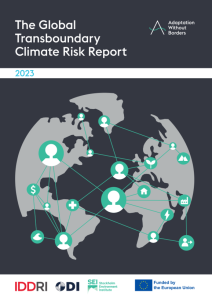

The Global Transboundary Climate Risk Report
Author(s):
Summary:
As their name suggests, transboundary climate risks do not respect national or international borders. They are being triggered by climate change and by our adaptation responses to that challenge. A climate hazard in one country may well have an impact that crosses national borders to affect its neighbours. In our interconnected world, however, its impact may also jump across entire regions and vast oceans to harm distant countries. From flooding in Bangkok that disrupts global industrial production, to the spread of diseases that hold back economies, transboundary climate risks are an immediate threat to our collective wellbeing. And they hinder the prospects of achieving global goals on climate adaptation.
Transboundary climate risks also include those transmitted by adaptation responses. While these responses can have positive results across borders and deliver shared benefits, they can also redistribute or even increase (rather than reduce) the risks, by shifting them to other countries, sectors and communities. This happens, for example, when countries impose export bans to protect domestic markets from food price shocks, which can turn a local shock into a global food crisis.
This report by Adaptation Without Borders rings the alarm bell on transboundary climate risks. It is the first collection of evidence on risks that undermine effective responses to climate change, yet that remain largely unrecognized: a ‘blind spot’ in both climate policies and solutions. It brings together the best available knowledge, drawing on a wealth of case studies.
The report is structured as follows:
- Part I: The state of knowledge on transboundary climate risks (p.17-28)
- Part II: Assessing 10 globally significant transboundary climate risks (p. 29-96)
- Part III: The solution space to managing transboundary climate risks (p. 97-113)
The report provides new evidence on ten transboundary climate risks of global importance that affect critical sectors and regions:
- Terrestrial shared natural resources: Chapter 2.1 assesses transboundary climate risks in shared river corridors in mountain regions that are facing increasing risks of melting glaciers, flood disasters and cross-border risks to infrastructure, energy distribution and livelihoods.
- Ocean and coastal shared natural resources: Chapter 2.2 provides an assessment on the risks of shifting open-ocean fish stocks in the Pacific region due especially to ocean warming. It focuses on the challenges in governance and collective management across borders, with a view of potentially high consequences for global food security, the stability of entire regions and countries, and livelihoods at local scales.
- Agricultural commodities and food security: Chapter 2.3 assesses the cross-border and cascading risks of climate change and adaptation decisions in the production and trade of key agricultural commodities (maize, wheat, rice and soybean) in global food supply chains.
- Industrial supply chains: Chapter 2.4 assesses how transboundary climate risk cascades via global industrial supply chains, making local risks global relatively quickly. It also explores gaps in integrated risk assessment across global supply chains, and a lack of information sharing and coordinated decision making across stakeholders that is critical for building resilience.
- Energy and sustainable energy transformation: Chapter 2.5 presents an analysis of climate change and extreme weather events on interconnected energy networks across borders, and the cascading risks to disrupted energy supplies on people. Further, it presents developments in policies for building more climate resilience in interconnected energy networks.
- Finance: Chapter 2.6 assesses transboundary climate risks in global financial systems, with a specific focus on risks to foreign direct investment (FDI). It explores climate risk assessment methods to better integrate these risks in international financial networks. This chapter "Transboundary climate risks and finance" has been authored by Irene Monasterolo, Research Programme Director and Anja Duranovic, Researsch Assistant at EDHEC-Risk Climate Impact Institute.
- Human health: Chapter 2.7 assesses climate change risks on the accelerated geographical spread of some vector-borne diseases by expanding the habitat for the vectors and by inducing human mobility. It looks at how adaptation responses in one country, such as enhanced climate-sensitive disease surveillance and control, can help neighbouring countries adapt to climate change and even reduce the global risk of disease spread.
- Human mobility: Chapter 2.8 takes a deep dive on transboundary climate risks and international labour markets, specifically looking at seasonal and guest worker arrangements and the indirect risks to the international flow of remittances.
- Livelihoods: Chapter 2.9 explores the multiple ways that climate change risks and adaptation responses can trigger cross-border risks to different livelihoods, and takes a deep dive on the implications for pastoralism in the Sahel region.
- Wellbeing: Chapter 2.10 explores transboundary climate risks to wellbeing in different adaptation contexts. It analyzes the potential opportunities and challenges for a just transition in the context of transboundary climate risks, including how adaptation responses to equity issues can displace risks from one community or sector to another.
Register to download PDF
Register/Log in| Type : | EDHEC Publication |
|---|---|
| Date : | 21/04/2023 |
| Keywords : |
Are Transboundary Climate Risks the Blind Spot in Our Climate Policies? |
| Editor : | Adaptation Without Borders |

